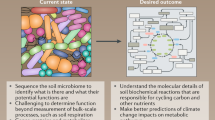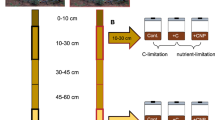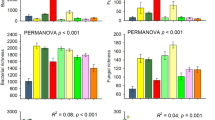Abstract
The sensitivity of soil microbial respiration to warming (Q10) remains a major source of uncertainty surrounding the projections of soil carbon emissions to the atmosphere as the factors driving Q10 patterns across ecosystems have been assessed in isolation from each other. Here we report the results of a warming experiment using soils from 332 sites across all continents and major biomes to simultaneously evaluate the main drivers of global Q10 patterns. Compared with biochemical recalcitrance, mineral protection, substrate quantity and environmental factors, the soil microbiome (that is, microbial biomass and bacterial taxa) explained the largest portion of variation in Q10 values. Our work provides solid evidence that soil microbiomes largely govern the responses of soil heterotrophic respiration to warming and thus need to be explicitly accounted for when assessing land carbon–climate feedbacks.
This is a preview of subscription content, access via your institution
Access options
Access Nature and 54 other Nature Portfolio journals
Get Nature+, our best-value online-access subscription
$29.99 / 30 days
cancel any time
Subscribe to this journal
Receive 12 print issues and online access
$209.00 per year
only $17.42 per issue
Buy this article
- Purchase on Springer Link
- Instant access to full article PDF
Prices may be subject to local taxes which are calculated during checkout




Similar content being viewed by others
Data availability
The raw data associated with this study are available at https://doi.org/10.6084/m9.figshare.20776243 (ref. 75).
Code availability
The code associated with this study is available at https://doi.org/10.6084/m9.figshare.20776243 (ref. 75).
References
Huang, H., Calabrese, S. & Rodriguez-Iturbe, I. Variability of ecosystem carbon source from microbial respiration is controlled by rainfall dynamics. Proc. Natl Acad. Sci. USA 118, e2115283118 (2021).
García-Palacios, P. et al. Evidence for large microbial-mediated losses of soil carbon under anthropogenic warming. Nat. Rev. Earth Environ. 2, 507–517 (2021).
Meyer, N., Welp, G. & Amelung, W. The temperature sensitivity (Q10) of soil respiration: controlling factors and spatial prediction at regional scale based on environmental soil classes. Glob. Biogeochem. Cycles 32, 306–323 (2018).
Mahecha, M. D. et al. Global convergence in the temperature sensitivity of respiration at ecosystem level. Science 329, 838–840 (2010).
Haaf, D., Six, J. & Doetterl, S. Global patterns of geo-ecological controls on the response of soil respiration to warming. Nat. Clim. Change 11, 623–627 (2021).
Hursh, A. et al. The sensitivity of soil respiration to soil temperature, moisture, and carbon supply at the global scale. Glob. Change Biol. 23, 2090–2103 (2017).
Karhu, K. et al. Temperature sensitivity of soil respiration rates enhanced by microbial community response. Nature 513, 81–84 (2014).
Zhou, J. et al. Microbial mediation of carbon-cycle feedbacks to climate warming. Nat. Clim. Change 2, 106–110 (2012).
Crowther, T. W. et al. The global soil community and its influence on biogeochemistry. Science 365, 6455 (2019).
Allison, S. D., Chacon, S. S. & German, D. P. Substrate concentration constraints on microbial decomposition. Soil Biol. Biochem. 79, 43–49 (2014).
Dungait, J. A. J., Hopkins, D. W., Gregory, A. S. & Whitmore, A. P. Soil organic matter turnover is governed by accessibility not recalcitrance. Glob. Change Biol. 18, 1781–1796 (2012).
Conant, R. T. et al. Temperature and soil organic matter decomposition rates—synthesis of current knowledge and a way forward. Glob. Change Biol. 17, 3392–3404 (2011).
Qin, S. et al. Temperature sensitivity of SOM decomposition governed by aggregate protection and microbial communities. Sci. Adv. 5, eaau1218 (2019).
Davidson, E. A. & Janssens, I. A. Temperature sensitivity of soil carbon decomposition and feedbacks to climate change. Nature 440, 165–173 (2006).
Fierer, N. et al. Cross-biome metagenomic analyses of soil microbial communities and their functional attributes. Proc. Natl Acad. Sci. USA 109, 21390–21395 (2012).
Bond-Lamberty, B. & Thomson, A. Temperature-associated increases in the global soil respiration record. Nature 464, 579–582 (2010).
Song, J. et al. A meta-analysis of 1,119 manipulative experiments on terrestrial carbon-cycling responses to global change. Nat. Ecol. Evol. 3, 1309–1320 (2019).
Delgado-Baquerizo, M. et al. A global atlas of the dominant bacteria found in soil. Science 359, 320–325 (2018).
Wang, X. et al. Are ecological gradients in seasonal Q10 of soil respiration explained by climate or by vegetation seasonality? Soil Biol. Biochem. 42, 1728–1734 (2010).
Gentsch, N. et al. Temperature response of permafrost soil carbon is attenuated by mineral protection. Glob. Change Biol. 24, 3401–3415 (2018).
Wang, C. et al. The temperature sensitivity of soil: microbial biodiversity, growth, and carbon mineralization. ISME J. 15, 2738–2747 (2021).
Wieder, W. R. et al. Explicitly representing soil microbial processes in Earth system models. Glob. Biogeochem. Cycles 29, 1782–1800 (2015).
Wan, J. & Crowther, T. W. Uniting the scales of microbial biogeochemistry with trait‐based modelling. Funct. Ecol. 36, 1457–1472 (2022).
Maestre, F. T. et al. Increasing aridity reduces soil microbial diversity and abundance in global drylands. Proc. Natl Acad. Sci. USA 112, 15684–15689 (2015).
Fierer, N., Colman, B. P., Schimel, J. P. & Jackson, R. B. Predicting the temperature dependence of microbial respiration in soil: a continental-scale analysis. Glob. Biogeochem. Cycles 20, GB3026 (2006).
Wagai, R. et al. Linking temperature sensitivity of soil organic matter decomposition to its molecular structure, accessibility, and microbial physiology. Glob. Change Biol. 19, 1114–1125 (2013).
Li, W. et al. Responses of Q10 to anthropogenic soil redistribution: synthetic effects of SOM composition and r/K-shifts of microbial community. Soil Tillage Res. 223, 105477 (2022).
Zimmermann, M., Leifeld, J., Conen, F., Bird, M. I. & Meir, P. Can composition and physical protection of soil organic matter explain soil respiration temperature sensitivity? Biogeochemistry 107, 423–436 (2012).
Soong, J. L. et al. Microbial carbon limitation: The need for integrating microorganisms into our understanding of ecosystem carbon cycling. Glob. Change Biol. 26, 1953–1961 (2020).
Allison, S. D., Wallenstein, M. D. & Bradford, M. A. Soil-carbon response to warming dependent on microbial physiology. Nat. Geosci. 3, 336–340 (2010).
Stone, B. W. G. et al. Life history strategies among soil bacteria—dichotomy for few, continuum for many. ISME J. 17, 611–619 (2023).
Kirschbaum, M. The temperature dependence of organic-matter decomposition—still a topic of debate. Soil Biol. Biochem. 38, 2510–2518 (2006).
Bradford, M. A. et al. Managing uncertainty in soil carbon feedbacks to climate change. Nat. Clim. Change 6, 751–758 (2016).
Fick, S. E. & Hijmans, R. J. WorldClim 2: new 1-km spatial resolution climate surfaces for global land areas. Int. J. Climatol. 37, 4302–4315 (2017).
Whittaker, R. H. Communities and Ecosystems (Macmillan, 1970).
Valentin Ș. & Levin, S. plotbiomes: R package for plotting Whittaker biomes with ggplot2 (v1.0.0). https://doi.org/10.5281/zenodo.7145245 (2018).
Maestre, F. T. et al. Plant species richness and ecosystem multifunctionality in global drylands. Science 335, 214–218 (2012).
Delgado-Baquerizo, M. et al. Changes in belowground biodiversity during ecosystem development. Proc. Natl Acad. Sci. USA 116, 6891–6896 (2019).
Campbell, C. D., Chapman, S. J., Cameron, C. M., Davidson, M. S. & Potts, J. M. A rapid microtiter plate method to measure carbon dioxide evolved from carbon substrate amendments so as to determine the physiological profiles of soil microbial communities by using whole soil. Appl. Environ. Microbiol. 69, 3593–3599 (2003).
Han Weng, Z. et al. Biochar built soil carbon over a decade by stabilizing rhizodeposits. Nat. Clim. Change 7, 371–376 (2017).
García-Palacios, P., Milla, R., Álvaro-Sánchez, M., Martín-Robles, N. & Maestro, M. Application of a high-throughput laboratory method to assess litter decomposition rates in multiple-species experiments. Soil Biol. Biochem. 57, 929–932 (2013).
Dacal, M., Bradford, M. A., Plaza, C., Maestre, F. T. & García-Palacios, P. Soil microbial respiration adapts to ambient temperature in global drylands. Nat. Ecol. Evol. 3, 232–238 (2019).
García-Palacios, P. et al. Pathways regulating decreased soil respiration with warming in a biocrust-dominated dryland. Glob. Change Biol. 24, 4645–4656 (2018).
Fraser, F. C. et al. On the origin of carbon dioxide released from rewetted soils. Soil Biol. Biochem. 101, 1–5 (2016).
Blagodatskaya, E. & Kuzyakov, Y. Active microorganisms in soil: critical review of estimation criteria and approaches. Soil Biol. Biochem. 67, 192–211 (2013).
Margenot, A. J., Calderón, F. J., Bowles, T. M., Parikh, S. J. & Jackson, L. E. Soil organic matter functional group composition in relation to organic carbon, nitrogen, and phosphorus fractions in organically managed tomato fields. Soil Sci. Soc. Am. J. 79, 772–782 (2015).
Thevenot, M., Dignac, M.-F. & Rumpel, C. Fate of lignins in soils: a review. Soil Biol. Biochem. 42, 1200–1211 (2010).
Bingham, A. H. & Cotrufo, M. F. Organic nitrogen storage in mineral soil: implications for policy and management. Sci. Total Environ. 551–552, 116–126 (2016).
Sokol, N. W. & Bradford, M. A. Microbial formation of stable soil carbon is more efficient from belowground than aboveground input. Nat. Geosci. 12, 46–53 (2019).
Harris, D., Horwáth, W. R. & van Kessel, C. Acid fumigation of soils to remove carbonates prior to total organic carbon or carbon-13 isotopic analysis. Soil Sci. Soc. Am. J. 65, 1853–1856 (2001).
Anderson, J. M. & Ingram, J. S. Tropical Soil Biology and Fertility: A Handbook of Methods (CAB International, 1993).
Bligh, E. G. & Dyer, W. J. A rapid method of total lipid extraction and purification. Can. J. Biochem Physiol. 37, 911–917 (1959).
Buyer, J. S. & Sasser, M. High throughput phospholipid fatty acid analysis of soils. Appl. Soil Ecol. 61, 127–130 (2012).
Frostegård, A. & Bååth, E. The use of phospholipid fatty acid analysis to estimate bacterial and fungal biomass in soil. Biol. Fertil. Soils 22, 59–65 (1996).
Rinnan, R. & Bååth, E. Differential utilization of carbon substrates by bacteria and fungi in tundra soil. Appl. Environ. Microbiol. 75, 3611–3620 (2009).
Herlemann, D. P. et al. Transitions in bacterial communities along the 2000 km salinity gradient of the Baltic Sea. ISME J. 5, 1571–1579 (2011).
Caporaso, J. G. et al. QIIME allows analysis of high-throughput community sequencing data. Nat. Methods 7, 335–336 (2010).
Edgar, R. C. Search and clustering orders of magnitude faster than BLAST. Bioinformatics 26, 2460–2461 (2010).
Edgar, R. C. & Flyvbjerg, H. Error filtering, pair assembly and error correction for next-generation sequencing reads. Bioinformatics 31, 3476–3482 (2015).
Egidi, E. et al. A few Ascomycota taxa dominate soil fungal communities worldwide. Nat. Commun. 10, 2369 (2019).
Kettler, T. A., Doran, J. W. & Gilbert, T. L. Simplified method for soil particle-size determination to accompany soil-quality analyses. Soil Sci. Soc. Am. J. 65, 849–852 (2001).
Bell, C. W. et al. High-throughput fluorometric measurement of potential soil extracellular enzyme activities. J. Vis. Exp. https://doi.org/10.3791/50961 (2013).
Legendre, P. & Legendre, L. Numerical Ecology. (Elsevier Science BV: 2012).
Oksanen, J. vegan: an introduction to ordination. https://cran.r-project.org/web/packages/vegan/vignettes/intro-vegan.pdf (2020).
Breiman, L. Random forests. Mach. Learn. 45, 5–32 (2001).
Wei, C.-L. et al. Global patterns and predictions of seafloor biomass using random forests. PLoS ONE 5, e15323 (2010).
Benito, B. M. spatialRF: easy spatial regression with random forest measurement. Zenodo. https://doi.org/10.5281/zenodo.4745208 (2021).
James, G., Witten, D., Hastie, T. & Tibshirani, R. An Introduction to Statistical Learning (Springer, 2013).
Andersen, R. Modern Methods for Robust Regression (Sage, 2008).
Yegorov, O. Robust fitting of linear model. R package version 1.2. http://cran.nexr.com/web/packages/rlm/rlm.pdf (2016).
Burnham, K. P. & Anderson, D. R. Model selection and multimodel inference: a practical information-theoretic approach. J. Wildl. Manag. 67, 655 (2003).
Burnham, K. P., Anderson, D. R. & Huyvaert, K. P. Erratum to: AIC model selection and multimodel inference in behavioral ecology: some background, observations, and comparisons. Behav. Ecol. Sociobiol. 65, 415–415 (2011).
Barton, K. MuMIn: multi-model inference. R package version 1.43. https://cran.r-project.org/web/packages/MuMIn/MuMIn.pdf (2020).
Schermelleh-Engel, K., Moosbrugger, H. & Müller, H. Evaluating the fit of structural equation models: tests of significance and descriptive goodness-of-fit measures. Methods Psychol. Res. Online 8, 23–74 (2003).
Sáez-Sandino, T. The soil microbiome governs the response of microbial respiration to warming across the globe. (2023); https://doi.org/10.6084/m9.figshare.20776243
Acknowledgements
T.S.-S. and A.G. were supported by FEDER/Ministerio de Ciencia, Innovación y Universidades-Agencia Estatal de Investigación/Proyect (CGL2017-88124-R). M.D.-B. was supported by the BES grant agreement number LRB17\1019 (MUSGONET), innovation programme under Marie Sklodowska-Curie Grant Agreement 702057 (CLIMIFUN), Ramón y Cajal grant (RYC2018-025483-I), a project from the Spanish Ministry of Science and Innovation (PID2020-115813RA-I00; SOIL4GROWTH) and a project PAIDI 2020 from the Junta de Andalucía (P20_00879). F.T.M. is supported by the European Research Council grant 647038 (BIODESERT), Generalitat Valenciana grant CIDEGENT/2018/041, by the Spanish Ministry of Science and Innovation (grant PID2020-116578RB-I00) and by the contract between ETH Zurich and University of Alicante ‘Mapping terrestrial ecosystem structure at the global scale’. E.G. acknowledges funding from Generalitat Valenciana and Europen Social Fund grant (APOSTD/2021/188). T.S.-S., A.G. and M.D.-B. were also supported by TED2021-130908B-C41 (URBANCHANGE). N.E. gratefully acknowledges the support of iDiv, which is funded by the German Research Foundation (DFG – FZT 118, 202548816), as well as by the DFG (Ei 862/29-1; Ei 862/31-1). C.C.-D. is supported by a Post-doc Research Scholarship in the context of the FCT funded project SoilRecon with reference BIPD_01_2021_FCT-PTDC/BIA-CBI/2340/ 2020 and acknowledges the Center for Research and Development in Agrifood Systems and Sustainability (CISAS) with references UIDB/05937/2020 and UIDP/05937/2020, also funded by FCT national funds. We thank the researchers originally involved in the BIODESERT, CLIMIFUN and MUSGONET projects.
Author information
Authors and Affiliations
Contributions
T.S.-S., P.G.-P. and M.D.-B. conceptualized the project. M.D.-B., F.T.M. and A.G. acquired funding. T.S.-S., M.D.-B., P.G.-P., F.T.M., C.P., E.G., B.K.S., J.W., C.C.-D., N.E. and A.G. conducted the investigation. T.S.-S. wrote the paper with all authors contributing to the drafts.
Corresponding authors
Ethics declarations
Competing interests
The authors declare no competing interests.
Peer review
Peer review information
Nature Climate Change thanks Yiqi Luo and the other, anonymous, reviewer(s) for their contribution to the peer review of this work.
Additional information
Publisher’s note Springer Nature remains neutral with regard to jurisdictional claims in published maps and institutional affiliations.
Supplementary information
Supplementary Information
Supplementary Figs. 1–10 and Tables 1–4.
Rights and permissions
Springer Nature or its licensor (e.g. a society or other partner) holds exclusive rights to this article under a publishing agreement with the author(s) or other rightsholder(s); author self-archiving of the accepted manuscript version of this article is solely governed by the terms of such publishing agreement and applicable law.
About this article
Cite this article
Sáez-Sandino, T., García-Palacios, P., Maestre, F.T. et al. The soil microbiome governs the response of microbial respiration to warming across the globe. Nat. Clim. Chang. 13, 1382–1387 (2023). https://doi.org/10.1038/s41558-023-01868-1
Received:
Accepted:
Published:
Issue Date:
DOI: https://doi.org/10.1038/s41558-023-01868-1
This article is cited by
-
Projected soil carbon loss with warming in constrained Earth system models
Nature Communications (2024)



